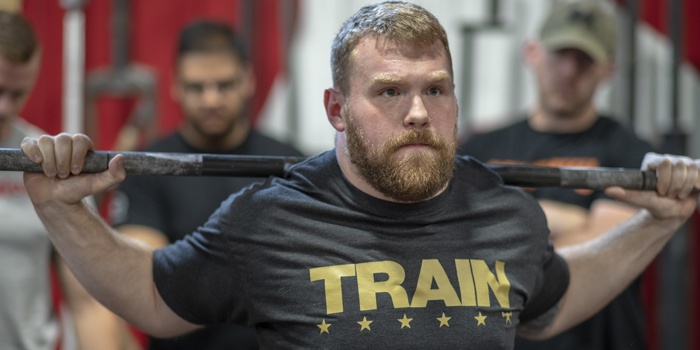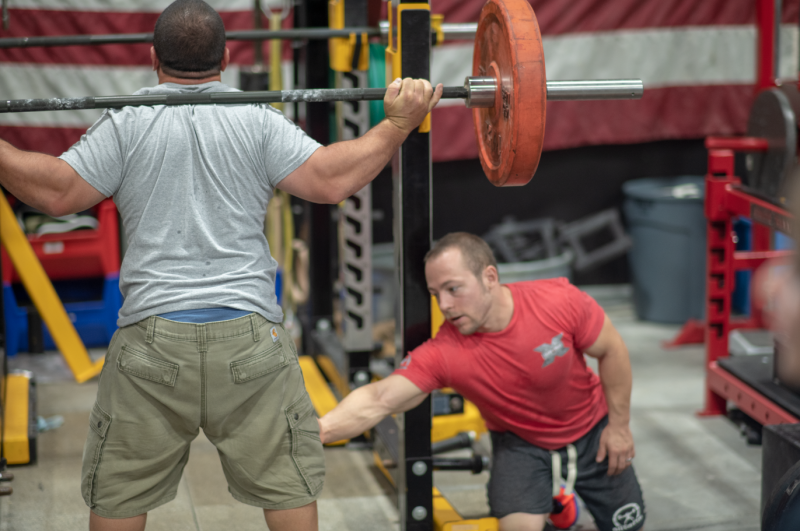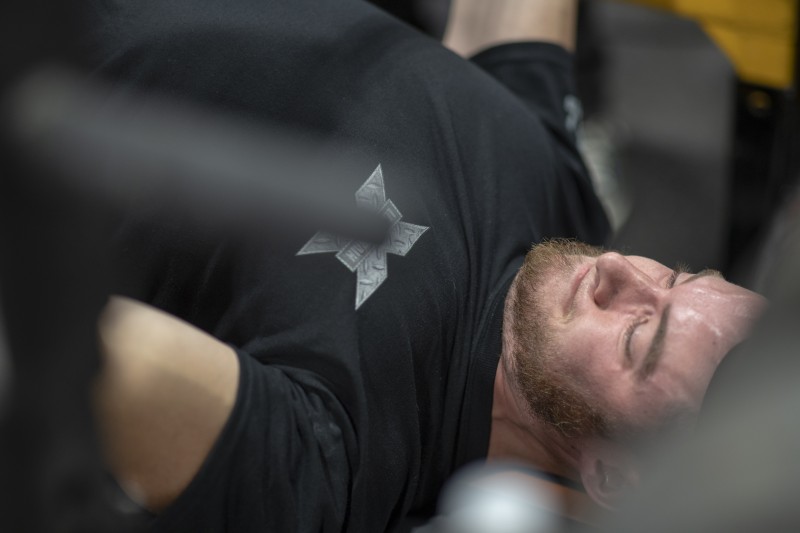
There are several factors that determine the amount of training volume a lifter should perform in an exercise program. One of these factors that many coaches wonder about and have different theories on is the athlete's body size. The most accepted truth I have heard is that it takes longer for the nervous system to recover for a larger individual. The truth, on the other hand, seems to be much simpler than that; it can’t be that the nervous system gets more exhausted by sending signals 20 centimeters farther. The levers made of the length of the arms, legs, torso, back, however, may be the answer. The simplest example is to take a biceps curl: the longer the arm is, the heavier it becomes on biceps because of the lever (moment arm). The shorter the arm, the less power is given to the gravity that makes you struggle with the weight. Similarly, in a bench press, the farther out of the body you come with your elbow, the greater the strain on the chest muscles because the load is down to the elbow (the other end of the humerus). Similarly, the closer you hold the bar, the more load will be put on the triceps.
I was watching a nature program with my children when I began thinking of these things. In the program, it was said that it takes a longer time for larger animals to recover than small animals. A larger animal that chases a smaller animal does not have the same stamina and requires longer recovery after the rush than the smaller animal needs. This is most likely because the body is exerted to a greater extent by the levers and the weight behind.
RECENT: Boris Sheiko's Thoughts on Westside Barbell
Consider two powerlifters who have exactly the same angles and technique, but one is 20 centimeters taller. Doing the same exercises, sets, reps, and weight, the bigger lifter would have lifted more volume after a training session than the smaller, because the lifter's moment arm in the lift would be longer. Just as a forklift truck can have a greater load farther into the forks, the shorter lifter manages to handle more weight than the larger lifter just because of the shorter levers they have. You have probably done some chest flyes at some point, and therefore you know that you get more stress on your chest muscles with flyes than at a regular dumbbell press, which causes you to train with less weight. Often you can see bodybuilders start by training dumbbells flyes, and when you start to get exhausted, you can continue in a regular dumbbell press. The reason for this is that the weight becomes heavier (i.e. gives a bigger load on the muscle insertion) in flyes than in a dumbbell press. It does not depend on the elbow being straight, but on the lever getting longer. If the lever is longer, a greater force on the muscle occurs.
What is Volume?
Volume is the multiplied sum of the number of sets, reps, and weight. For example, if we lift 100 kilograms for six sets of six reps we have a total volume of 3600 kilograms (100 kilograms x 6 reps x 6 sets = 3600 total volume). Should we increase the weight to 110 kilograms while keeping the sets and reps the same, the volume will be 3960 kilograms, which will be a significant increase.
The timetable also matters. Say you lift 100 kilograms for six sets of six, and it takes you 30 minutes. You've lifted 120 kilograms per minute, on average. If you instead go through the exercise in 20 minutes, you have lifted 180 kilograms per minute, which is a much higher volume. One way to increase the volume can be the intensity. Say that you get the same exercise to 15 minutes, so you're at 240 kilograms per minute, which is a doubling of the volume. Maybe you could have lifted more if you rested, which is often the case, but it would have altered the conditions away from how you wanted to train for comparison.
A longer lever generates more strain than a shorter lever. In other words, if your upper arm is longer than it is on your buddy, your chest muscles will be subjected to a higher load in relation to the weight you lift compared to your mate who has a shorter moment arm from the elbow to the chest muscular attachment. The same applies to all exercises. If a longer lifter is squatting, the lever will load the knee and lumbar spine more per lifted kilogram than on a smaller lifter. Obviously, less training volume per training session is required, as the load volume will still be the same as it would be at a smaller lifter.
Concepts to Consider
- Weight — Mass that becomes a load by gravity pulling it downwards with 9.82 meters per second per kilogram; gravitation makes the weight
- Sets — The number of rounds you complete the exercise in
- Reps — The number of times you lift a weight per set
- Volume — Number of sets multiplied by the number of reps multiplied by the weight (sets x reps x weight)
- Force — Mass multiplied by acceleration, generating a force
- Load — Strength training made to maintain weight
- Torque Arm — The lever that connects the load point to the weight-bearing point
- Timeframe — Lifted kilograms per minute during a training session
Relative Strength
Relative strength will also be of great importance for planning the volume of your workout and goes hand in hand with your size. The strength is relative to your body size. A smaller person is generally stronger than a larger person, relative to body size. A smaller lifter usually increases more than one who is heavier, relative to bodyweight. It is called relative strength. This is the reason that in powerlifting something called the Wilk's formula is used to convert weight to points relative to bodyweight. This is used for comparison of strength between lifters of different body sizes. This is often something that heavier lifters don’t want to hear or talk about, but usually the one who has gained the most weight and is the strongest is the one who resonates. And this is true if you count something called absolute strength; it is not in relation to bodyweight but only in relation to the gravity of the earth. It's a common mistake to try to copy the programming of a successful athlete who has a different body composition than you have.
I have heard several times that European weightlifters tried to copy Chinese weightlifting training programs, believing that their training program is what gave them so many good athletes. They ignored the fact that these lifters are usually smaller, have a different bone structure, and have different angles that give a different starting position with the barbell. If the bar is three to five centimeters higher at the tibia, the start of a squat will look different. It is not the same start of muscle activity. The entire muscle chain will be working differently. This makes sense if you know how your levers look in biomechanics. If you have a long forearm, the biceps are more loaded in a curl than if you have a short forearm. If you have long thighs, your muscles are different than if you have short thighs.
It may sound like speculative nonsense, but the truth is that this knowledge can change your training more than you think. I have often been told that I exercise too much volume in periods, but I have found that I respond well. Most of the people I have trained with have been significantly bigger than I am. Instead of feeling I'm doing wrong and ought to work differently, or looking at my athletes I'm training and thinking they're lazy, I have an explanation.
My hoping after you read this article is that:
- You will find a better structure in your training sessions.
- You will see cause and effect better.
- You will be able to calculate volume better.
- You won’t waste time on programs that don’t work for you.
Stefan Waltersson is a professional strength coach certified by Westside Barbell, lecturer, physiotherapist, author, personal trainer, kinesiologist, sports massage therapist, nurse assistant and founder of Seminoff Sport & Rehab in 2004. Stefan has previously worked in neurology (Sahlgrenska University Hospital) with researching doctors in microbiology and clinical chemistry. Check out his website at http://seminoff.se/.













As I read you article, it seems main takeaway is that larger lifters need less programmed volume than smaller lifters and biomechanics will compensate the difference. Have you any thoughts on estimating the difference for larger/smaller lifters in comparison to someone of average size?
Det är något jag funderat på mycket men ur en lite vriden vinkel..
BTW jag är med i frågeställningen, men så sjukt nyfiken på som egentligen avgör. Jag har gjort experiment som jag inte vågar skriva här ;-)
Detta är bara lite tankar du är långt mer teoretiskt/teknisk kunnig än jag men det är många år jag testat. Först träffar jag en kort 75kg kille, som är sjukt mkt starkare än alla på gymmet. Vi pratar och han tränar på ett sätt jag aldrig hört talas om. Gissa avr han hade varit? Japp hos Mr Louis himself!
Inget fett på kroppen o bänkar samma som mig detta var mitten sent nittiotal, jag vägde 40kg mer än honom. Han säger något om avståndet mellan revbenens nedersta del ovan solar plexus samt ryggraden. Det är ju helt rätt att någon med stort avstånd mellan ryggrad o revbenen o på det korta armar lättare bänkar mkt. jag hade inte tänkt på om man föds med det med det verkar så.
Det finns oxå enorma skillnader. Åratal senare träffar jag en kille med mkt kort ben och lååång rygg.Nä inte dvärg symptom men när han böjde o marka tänkte man på det. jag minns att han sa att efter en markdag var han totalt slut mkt längre än böjdag. Jo tänkte jag det tro fan det, hävstångskraften blir ju enorm. Som avslut på min tankeställare tänker jag sen på en tjej vi båda känner(jag mer nära)som du hjälpt mkt. Vi är är 175cm resp 178 cm till hennes favör men jävlar vad långa lårben hon har vilket jag försökt hitta lite vetenskap bakom ang tekniker. jag har roat mig lite mad att leta efter personer med samma längd men olika längd på bla lårben. Men gått bet.
Bara lite tankar...
Ok om jag kortar o översätter delar av din artikel? På mina sidor med hänsvisning till dig o Seminoff?
But as always, there is more things to add even the article may seem very detalied. How long is your humerus compared to your radius/ulna, how long torso do you have, how does the hipsocket look like and how long is your femur compared to the tibia/fibula. We could go crazy about this, but in my opinion just knowing there is a difference you get a bigger understanding how to set up your program.
Jason, yes to compete under the same conditions, only people with the same genetics should compete. But life's not fair, either you're good at powerlifting or you're good at something else. Just find your sport you have the genetics for or accept that you cant be best at the sport you love and compete just because you love it.
Thanks for your comments!